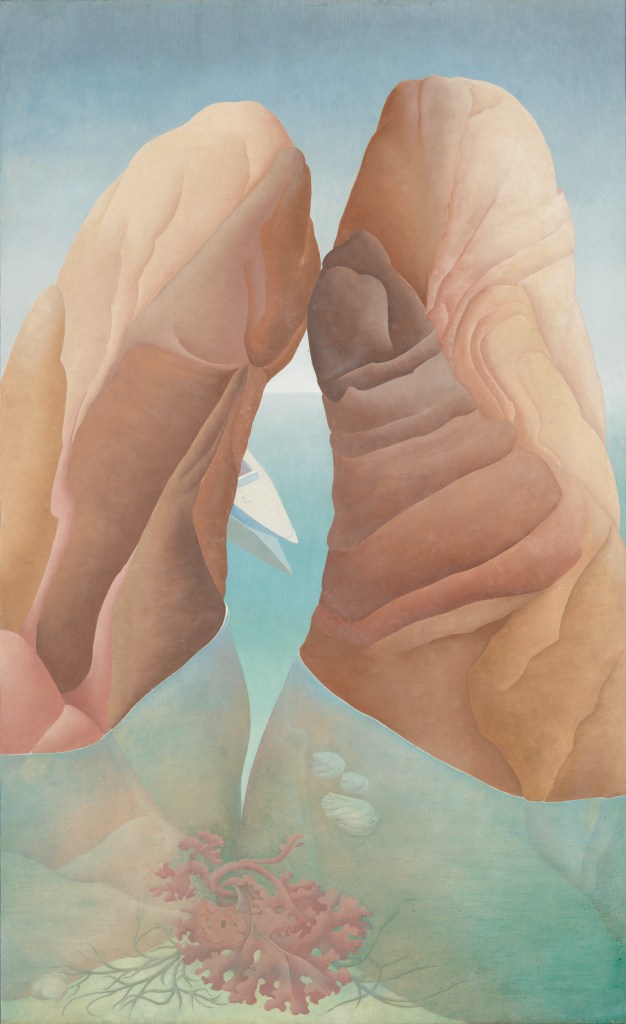
Hermione Eyre has narrated this article for you to listen to.
Ithell Colquhoun was always a bit of a mystery surrealist. Her greatest hit is the unsettling, dream-like ‘Scylla’ (1938), a painting of two towering cliffs, which could equally be thighs in the bath. The prow of Odysseus’s Argo peeps through them. The pubic hair is seaweed, and there are shells, but, as far as discernible, no crabs. The point of view of the painting is that of the titular monster Scylla, lying in wait. It’s witty and disturbing; mythic and domestic. A British surrealist high point, frequently anthologised.
This aside, her name was relegated to lists. She was at Dali’s lecture in London in 1936 when he got his head stuck in a diving helmet; she sat for Man Ray in Paris; she had her work censored from the 1942 edition of Artists of Fame and Promise (the annual gig Lucian Freud dubbed ‘artists of shame and compromise’). She was one of the gang, in other words. Except now thanks to this new solo Tate show, we see Colquhoun for the outstanding eccentric she was. Her creativity flowed all her life – paintings, carvings, visions, rites, poetry. Her art at first was quite conventional. She turned out charismatic history paintings at the Slade, hugely skilled, even if one feels she is wearing the painterly equivalent of a corset. Then came the mind-expanding years with the continental surrealists, the Rorschach-style blots, and the slow-motion career car-crash that began with ‘automatic’ scribbles and ended, as these things do, with ‘sex magic’ diagrams in a hut in Cornwall.
It is an exhilarating, uneven exhibition. Some is staggeringly good, while other bits resemble hippie detritus on a stall at Camden Market. For the catalogue, the Tate got in all their favourites: Linder, the eco-feminist brigade, and someone called Gwenno writing in dual Cornish/English. Well, Colquhoun’s work does contain multitudes, because it traced the shape of the 20th century itself.
Born in 1906, in Assam, a daughter of the British Raj, her parents sent her home aged one, but she always yearned for India. ‘What I need, but cannot have, are fireworks, carnival, gay gods embracing, coloured powder thrown at everyone, ritual dance and above all the microtone rhythms compared to which all others are crude…’ Instead, she got Cheltenham Ladies’ College and Henry Tonks at the Slade. She won the Slade Summer Composition prize for ‘Judith Showing the Head of Holofernes’ (1929). In person it feels a little constricted, effortful and strikingly similar to the work of Winifred Knights, also taught by Tonks. Tonks warned Colquhoun: ‘The only danger is that with your curious and active mind you may be led to run after all strange subjects. You go to gather strawberries and you come back with two strange spiders and a beetle instead.’
Her creativity flowed all her life – paintings, carvings, visions, rites, poetry
Sure enough, she was soon applying to join the Hermetic Order of the Golden Dawn. Later it was Aleister Crowley’s own Ordo Templi Orientis; then Dion Fortune’s Society of the Inner Light. Druids, Co-Freemasonry, theosophism, kabbalism, alchemy and even UFOs would all attract her loyalty over time. It is rather touching to notice in her memoirs how conscientiously, how staunchly, how politely she approached the netherworld of reason.
By 1939 she had reached her zenith, with a joint show with Roland Penrose at the Mayor Gallery. Her work was often uncanny but still exquisitely ‘finished’ and controlled on the surface. She was, to quote curator Katy Norris, ‘at the centre of British surrealism’.
It was not to last: two years later, E.L.T. Mesens sacked her from the group when she refused to join ‘the proletariat revolution’ (she said she was an artist, not an activist) and because she would not give up her occult orders. In 1942, her brilliant, Magritte-like ‘The Pine Family’ (missing from this show, sadly – did the Tate ask for a loan from the Israel Museum?) was rejected from Artists of Fame and Promise on grounds of indecency. She gave them ‘Tree Anatomy’ instead. A bold choice. According to the Tate’s often unintentionally hilarious catalogue, this depicts a ‘vulvic cave, as if the tree phallus has yawned, and at its core opened to show its inner yonic otherworld […] A clitoral light shines… could this be an eco-feminist beacon?’.

The tone is so delightfully pseudish I could quote reams more. Kew Gardens was created ‘in support of imperial domination’, apparently (and you thought Ithell just went there to paint the waterlilies!), while ‘women’ is, ‘with or without quotation marks, an unstable category that includes, and has always included, a great diversity of bodies and experiences. It is used in this essay in an explicitly trans-inclusive way…’ On the whole, I would rather have had more about Colquhoun, really; how much her work sold for, whether she was a synaesthete, how close her friendship was with Gluck and similar unanswered questions.
On a life-changing holiday to Switzerland with the surrealists in 1942, she discovered automatic techniques such as fumage (marks made by holding a piece of paper above a candle), decalcomania (peeling paper off paint to patterns behind), and, of course, frottage (literally rubbing, as in bark rubbing). She was not in charge of her work any more, but receiving it.
Then she fell in with Toni del Renzio, surrealist bad boy, ‘con man and homosexual’, she would later allege. Before they met, he derided her paintings as ‘sterile abstractions’ in his magazine Arson. Still, she ended up marrying him – and paying off his magazine’s debts. After two years living together in Bedford Park, west London, they divorced, and she felt west Cornwall calling, where ‘there is some balsamic quality in the air that never fails to bring healing’.
In the 1970s she started signing herself by her magical name, Splendidior Vitro ‘more shining than crystal’. She produced her Diagrams of Sex Magic, which the Tate presents not in the show but as a separate book, sold in the shop. And her final achievement was a marvellous tarot, exhibited in Newlyn Art Gallery in 1977. And now it seems all those divine rites and incantations have worked. The goose of Hermogenes (about which she wrote a roman noir) has finally come to land, because this tribute of a show is transferring to Tate Britain in June.







Comments